Logic Supply LGX AG150 Fanless System Review: Cedar Trail or Cedar Trial?
by Dustin Sklavos on May 28, 2012 11:30 PM EST- Posted in
- kiosk
- Systems
- Atom
- Cedar Trail
Application and Futuremark Performance
It's unreasonable to expect that the Logic Supply LGX AG150 is going to set the world on fire with its performance, but it's important to understand that it's not supposed to either. The LGX AG150 is designed to fulfill a specific purpose: offering x86 performance in a fanless enclosure for commercial and industrial applications where performance is a secondary priority to connectivity and x86 support. Nevertheless, let's put performance in perspective with a few different systems.
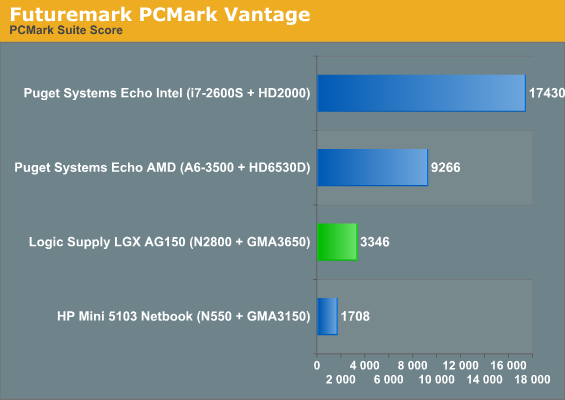
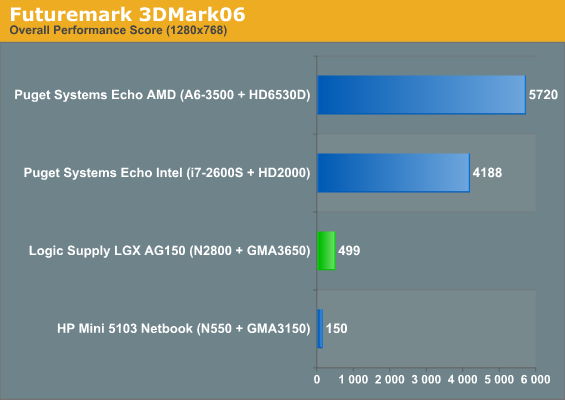
Amusingly, PCMark 7 just crashes outright on the LGX AG150's Atom N2800, and 3DMark 11 won't run due to the lack of DirectX 11 support (much less the lack of DirectX 10 support that prevents 3DMark Vantage from running). The GMA 3650 lives up to Intel's claim of twice the performance of the old Atom's GMA 3150 and then some. The problem is that Intel could've claimed ten times the performance and it still would've been dire.
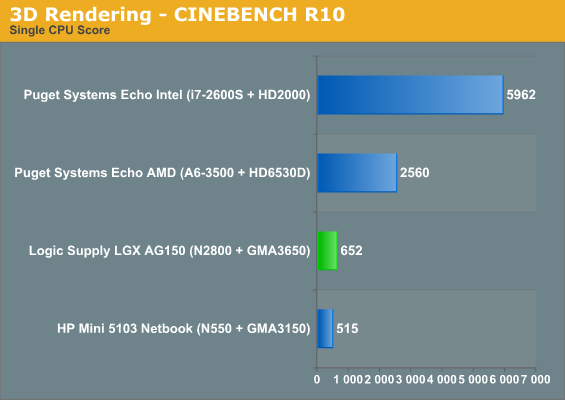
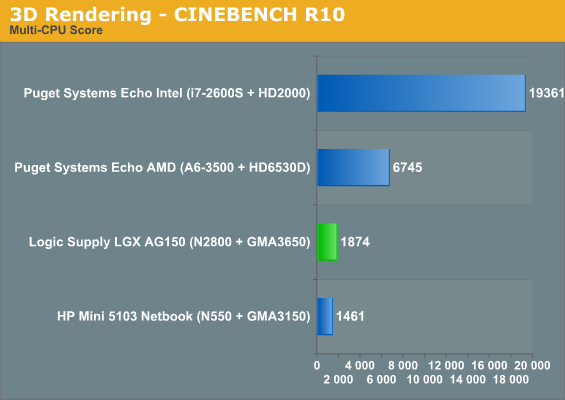

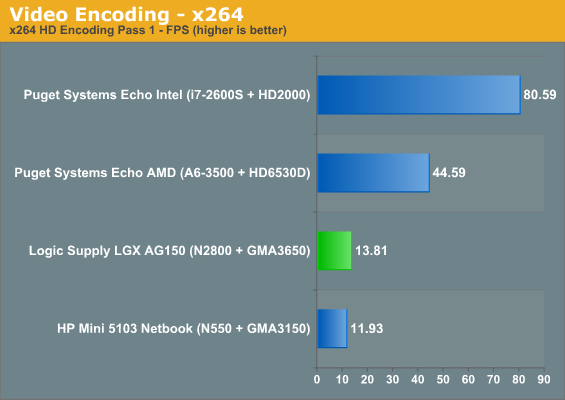
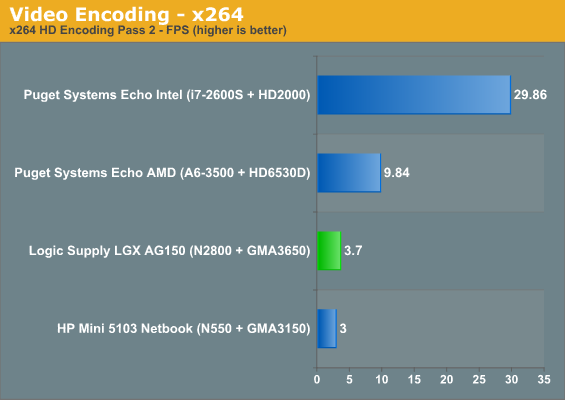
The difference in performance between the N550 and the new N2800 basically lines up with the 366MHz difference in core clocks between the two models. You want to be more impressed by the improvement in performance within thermal envelope; after all, the N2800 is able to get a decent boost in clocks over the N550 while reducing TDP by two watts. The problem is that Intel hasn't changed anything in the architecture since it was introduced. It's not hanging that badly when you consider the top two chips on the list pull ten times as much power, but we know things can be better.










46 Comments
View All Comments
hobbesmaster - Tuesday, May 29, 2012 - link
I'm assuming he meant POS as "Point of sale" instead of "piece of s***" The two often go hand in hand, but the issues are usually software!A lot of those systems are moving to USB though from what I understand. Regardless, this should handle an XGA touch screen fine which is probably all its intended to do.
They also list this under automotive, that wouldn't be a bad application either. You'd have a WVGA screen at max there.
beginner99 - Tuesday, May 29, 2012 - link
Even though its obviously intels lack of creating useful drivers once more as the producer of a system requiring such a driver i would not buy it if it doesn't work...so Logic IMHO is to blame too at least partially. But it seem to be the trend to release "faulty" products anyway.khimera2000 - Tuesday, May 29, 2012 - link
This review has some nice information, but it leaves so many questions that should not of cropped up. How does it perform against the last generation on both sides? how does it compare to the current generation from its competitor?The last time I checked it was the E-series that AMD marked as there "power efficient line" why is this being compared to an A6? Why was it not compared to an E-450, or at least a E-350? at least these two would be in the same area, and so would be perfect for comparison against an Atom N2800.
Without a point of comparison against other power efficient parts I look at the Data as a wash of useless. there's nothing in there that's relevant if its not seeing how it does against its competition.... and at least in my head that's the E-350, E-450, and VIA's cluster off product offerings.
I don't care who comes out on top, I just want to know how heavy the trade off is at this level of power draw, I want to know if bad drivers can result in a system that has to push hotter then its competiters, I would like to see how far these chips have advanced... also a brief rundown on each companies secret sauce would be a nice touch... refreshers always help :)
Spunjji - Tuesday, May 29, 2012 - link
Looks like you beat me to it! ;)I'm guessing the usual caveat of testing the systems they had to hand applies here, but you're right, the comparative data isn't of much use.
Credit where it's due though; this information does at least tell us that Atom is somehow more useless than ever on the desktop.
JarredWalton - Tuesday, May 29, 2012 - link
Bingo! Unfortunately, most of what we have on hand is limited, and I'm pretty sure none of us are interested in buying our own low-end Atom nettops. It's partly a problem of simply not getting enough of these types of systems for review, and when we do get systems they're often sent to different reviewers. Anand has played with a nettop at some point, so have I, and so has Ganesh. Most of those were a year ago or more, though, and so there's not a lot of overlap in the performance results.UrQuan3 - Monday, June 4, 2012 - link
Wish we could arm-twist LogicSupply a bit for the other review units since they seem to stock AMD E-series and Via Nano systems as well as Atoms.Spunjji - Tuesday, May 29, 2012 - link
For the curious:http://www.silentpcreview.com/Jetway_G-T40E
Pretty much what I'd imagined - Intel win for power consumption and thermals, AMD win for just about everything else. That 28nm shrink of Brazos needs to come sooner.
randinspace - Tuesday, May 29, 2012 - link
I think at least part of the answer to your question lies in the fact that Logic Supply themselves seems strangely (tragically? misguidedly?) married to the Atom if Brazos' presence in only one of their fanless systems is any indication.Spunjji - Tuesday, May 29, 2012 - link
A comparison to / mention of Brazos would have been nice, what with it being the prime competitor in this market! I'd really like to know how Intel's update changes the performance stakes, as Brazos was never that far ahead on the CPU side to begin with. I understand that you may not have had a system to hand but some passing comment would be lovely.silverblue - Tuesday, May 29, 2012 - link
Brazos is a fine competitor, however it'd be an unfair comparison as you mentioned above because of its higher power consumption and temperatures. Brazos-T is on the way which should improve on that.Ironically for AMD, Brazos is much faster at single threaded workloads than Atom; it's only when Atom's HT is leveraged that the two get much closer.